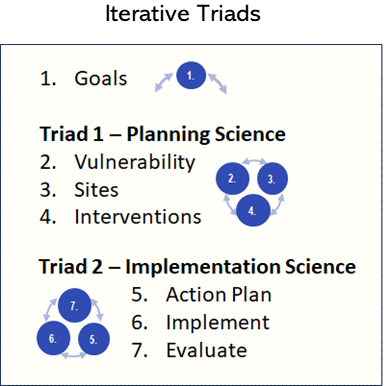What Key Concepts Are Behind the Organon?
Environmental management aims to protect, restore and conserve functional, resilient, and self-sustaining natural systems. Resilient natural resources ensure the provision of resilient ecosystem services for resilient human communities.
Boosting resilience depends on:
- understanding vulnerability (the degree of exposure to threats plus the sensitivity and adaptive capacity of the system to resist or recover); and
- creating new management strategies to reduce vulnerability to rapidly changing environmental conditions.

Achieving resilience requires a coordinated flow of information between planning science (Triad 1) and implementation science (Triad 2) to inform continuous evaluation and improvement of adaptive management outcomes.
The Organon’s double-sided arrows and spinning triads reflect this highly fluid and iterative process, where advances in any one step can power further refinements in other steps:
Step 1. Goals: Clearly defined goals are an essential start for bounding and guiding a focused effort. Everything that follows is devised in the context of the goal, and the goal may need to be reconsidered through time based on what is learned in any step.
Triad 1, Steps 2-3-4: Vulnerability assessments are tailored to inform site evaluation and intervention design, with iterative learning marking the interconnected nature of these steps. The combined planning information then informs Triad 2.
Triad 2, Steps 5-6-7: Here, action planning uses information from Triad 1 and specifies monitoring methods to track the implementation of interventions and evaluate success at achieving intended outcomes. This process could result in ongoing improvements to the action plan, again underscoring the interconnected nature of these steps.
Embracing collaboration through community engagement and public participation is essential throughout this iterative process. Partnering with local leaders, interest groups, community members, and experts supplements scientific efforts with place-based knowledge, ensures informed decision-making as the work evolves, and fosters community ownership of results.
Throughout the collaborative process, a project may have multiple iterations of information flow between triads, among steps within triads, and even back to step one for re-evaluation and adjustment of goal and scope, thereby closing the Organon circle.
